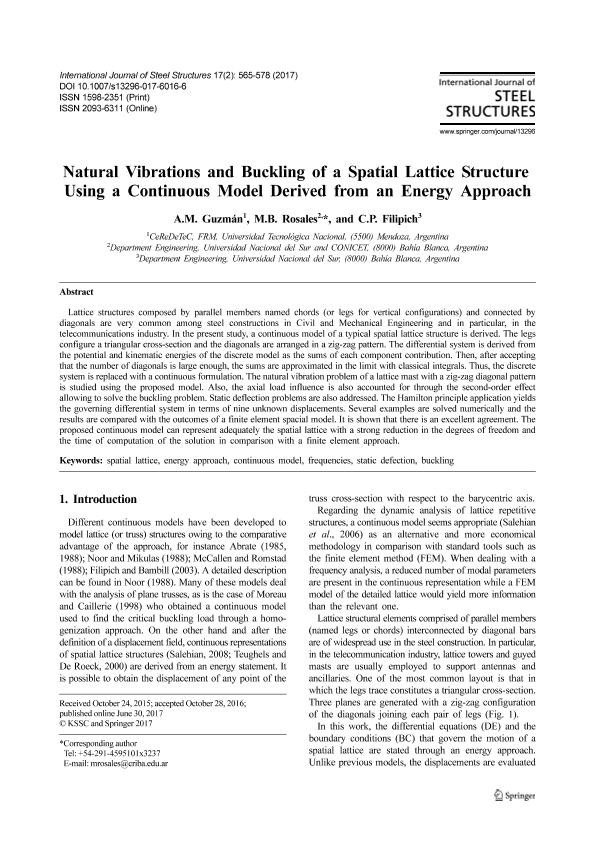Mostrar el registro sencillo del ítem
dc.contributor.author
Guzmán, Alberto Marcelo
dc.contributor.author
Rosales, Marta Beatriz

dc.contributor.author
Filipich, Carlos Pedro

dc.date.available
2018-05-02T17:33:11Z
dc.date.issued
2017-06
dc.identifier.citation
Guzmán, Alberto Marcelo; Rosales, Marta Beatriz; Filipich, Carlos Pedro; Natural vibrations and buckling of a spatial lattice structure using a continuous model derived from an energy approach; Korean Society of Steel Construction; International Journal of Steel Structures; 17; 2; 6-2017; 565-578
dc.identifier.issn
1598-2351
dc.identifier.uri
http://hdl.handle.net/11336/43875
dc.description.abstract
Lattice structures composed by parallel members named chords (or legs for vertical configurations) and connected by diagonals are very common among steel constructions in Civil and Mechanical Engineering and in particular, in the telecommunications industry. In the present study, a continuous model of a typical spatial lattice structure is derived. The legs configure a triangular cross-section and the diagonals are arranged in a zig-zag pattern. The differential system is derived from the potential and kinematic energies of the discrete model as the sums of each component contribution. Then, after accepting that the number of diagonals is large enough, the sums are approximated in the limit with classical integrals. Thus, the discrete system is replaced with a continuous formulation. The natural vibration problem of a lattice mast with a zig-zag diagonal pattern is studied using the proposed model. Also, the axial load influence is also accounted for through the second-order effect allowing to solve the buckling problem. Static deflection problems are also addressed. The Hamilton principle application yields the governing differential system in terms of nine unknown displacements. Several examples are solved numerically and the results are compared with the outcomes of a finite element spatial model. It is shown that there is an excellent agreement. The proposed continuous model can represent adequately the spatial lattice with a strong reduction in the degrees of freedom and the time of computation of the solution in comparison with a finite element approach.
dc.format
application/pdf
dc.language.iso
eng
dc.publisher
Korean Society of Steel Construction

dc.rights
info:eu-repo/semantics/openAccess
dc.rights.uri
https://creativecommons.org/licenses/by-nc-sa/2.5/ar/
dc.subject
Spatial Lattice
dc.subject
Energy
dc.subject
Frequencies
dc.subject
Static Deflection
dc.subject
Buckling
dc.subject.classification
Otras Ingeniería Civil

dc.subject.classification
Ingeniería Civil

dc.subject.classification
INGENIERÍAS Y TECNOLOGÍAS

dc.title
Natural vibrations and buckling of a spatial lattice structure using a continuous model derived from an energy approach
dc.type
info:eu-repo/semantics/article
dc.type
info:ar-repo/semantics/artículo
dc.type
info:eu-repo/semantics/publishedVersion
dc.date.updated
2018-04-18T17:43:11Z
dc.identifier.eissn
2093-6311
dc.journal.volume
17
dc.journal.number
2
dc.journal.pagination
565-578
dc.journal.pais
Corea del Sur

dc.journal.ciudad
Seúl
dc.description.fil
Fil: Guzmán, Alberto Marcelo. Universidad Tecnológica Nacional. Facultad Regional de Mendoza; Argentina
dc.description.fil
Fil: Rosales, Marta Beatriz. Consejo Nacional de Investigaciones Científicas y Técnicas. Centro Científico Tecnológico Conicet - Bahía Blanca; Argentina. Universidad Nacional del Sur. Departamento de Ingeniería; Argentina
dc.description.fil
Fil: Filipich, Carlos Pedro. Universidad Nacional del Sur. Departamento de Ingeniería; Argentina
dc.journal.title
International Journal of Steel Structures

dc.relation.alternativeid
info:eu-repo/semantics/altIdentifier/url/https://link.springer.com/article/10.1007%2Fs13296-017-6016-6
dc.relation.alternativeid
info:eu-repo/semantics/altIdentifier/doi/http://dx.doi.org/10.1007/s13296-017-6016-6
Archivos asociados
